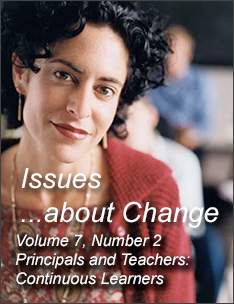Three Principals Who Are Continuous Learners
During our study of the three principals' schools, we gathered information about the principals' practices as leaders and consequently, as continuous learners. Each of these principals devoted attention to her own development and was quite visible to her staff as a learner. She made sure not only that the staff knew of her efforts to keep herself informed but that they experienced her application of that learning. The teachers in these principals' schools verified that their principals were constantly learning. One teacher said, "Professional staff development is definitely one of the strengths of our principal. She reads incessantly. She goes to workshops. She knows incredible people all over the country. She just has resources at her fingertips that I think a lot of people don't have. And so she brings in a lot of people and she has changed the school to a more school-wide focus" (Southwest Educational Development Laboratory, 1998).
One of our researchers told a revealing story of her first visit to Barbara McNamara's (1) school where Barbara had been serving for seven years. She was waiting for Barbara in her office and noticed a current and well used copy of Education Evaluation and Policy Analysis with lots of yellow sticky notes and dog-eared pages. Barbara seemed to be not only reading it, but studying it and using it as a reference. The teachers at her school associated her with constant reading and attending conferences, as depicted in comments such as "Anytime we go to her with an idea she knows what we are talking about. She has read about it or heard about it or worked with it" (Southwest Educational Development Laboratory, 1998). Within three years of beginning to teach, Barbara earned a Master of Education in Administration. After ten years of teaching, she took a two-year break to pursue a Ph. D. During that time she worked as a graduate research assistant in her state's university system. While a graduate research assistant, she was invited to participate in the development of her state's new teacher appraisal system. Later she participated in leadership training with SEDL's Leadership For Change and took a one-semester sabbatical from being principal to again focus on her Ph.D. studies.
Linda Aiken was also viewed by her staff as someone who does extensive reading and attending workshops for purposes of her own learning. A typical example offered by one of her teachers was, "I think we've got a principal that's always willing to learn new things. She is always sharing ideas with us of what she's learned. She herself is going to workshops and things like that. She's a member of several councils. She's involved in the PTA whereas before the administrators were never involved in that kind of stuff that goes on in the school" (Southwest Educational Development Laboratory, 1998). Linda had a reputation for being extremely effective in networking for her own professional development and in turn to access resources for her school. In addition to her 14 years of teaching at the elementary level and seven years as a principal, her professional experience included membership on various district level committees, supervision of elementary student teachers, and numerous workshop presentations. She had a long list of trainings and workshops in which she had participated as part of her commitment to her professional growth.
Patricia Sommers used her constant learning and application of what she had learned when the school district decided to reorganize a junior high school into a middle school. She spent seven years as principal of that middle school and developed the staff as a professional learning community. One staff member said, "The middle school concept was there. And she's sharp and she knew what was out there. She knew what was cutting-edge" (Southwest Educational Development Laboratory, 1998). She served in six professional positions during her 25 years in education: teacher, assistant principal, principal, counselor, supervisor of secondary instruction, and supervisor of middle level education. While principal, she worked with the Middle Grades School State Policy Initiative sponsored by Carnegie Foundation. She maintained a network of colleagues across her state and involved herself both in learning from these people and with them. She continued to conduct professional development workshops on leadership, school improvement, and school-based management in addition to participating in the design of certification programs to meet the new middle level education professional standards for her state.
Each of these principals, who were continuous learners, had been recognized by others for her leadership. University, district, and state leaders would call on these women for participation on committees and task forces and completion of other projects in their area before, during and after their success in PLC development. Their experiences in these arenas appeared to have contributed to the PLC work. Each woman remained active in such endeavors. Linda actively served on several committees. Barbara continued to teach graduate courses. Patricia conducted leadership training throughout her state. Each made good use of the contacts beyond her immediate professional circle.
These principals were each proactive about their own professional development and regularly put themselves into settings where they would have opportunities for learning. We characterized them as always scanning the horizon for new information that would improve learning and student success at their schools. They would then apply that new information at their schools, overtly modeling the learning and its application. In so doing, each principal left her imprint on her staff. Essentially, each woman turned her own ongoing learning into capacity building among the staff of her respective school and each staff used its increased skills to improve learning conditions for students at the schools.
(1) Pseudonyms are used for the principals discussed in this paper.
Next Page: Strategies Used by Principals to Develop Professional Learning Communities

